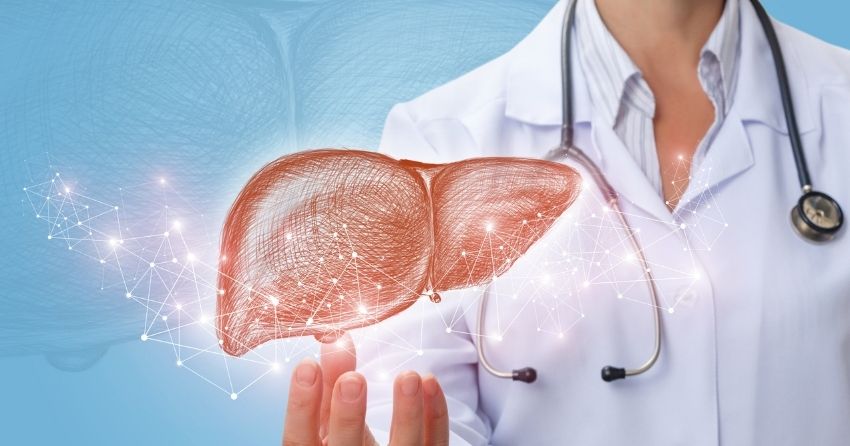Long Live Your Liver: Recent Study Shows How NMN Supports Liver Health

The liver is an essential but often overlooked organ when it comes to healthy aging. With age, liver function tends to decline, increasing the risk of scarring, which develops when abnormal amounts of scar tissue accumulate in the liver in response to injury or inflammation. While scarring itself causes no symptoms, this buildup of scar tissue is an early indicator of progression to irreparable liver damage that occurs when healthy tissue is replaced by dysfunctional scar tissue. Liver injury can originate for a multitude of reasons, but the most common causes are alcohol abuse, infection, and excess fat accumulation.
While early-stage liver scarring is reversible, the later stages of liver damage are permanent. In its earliest stages, liver scarring triggers hepatic (liver) cell death, increases pro-inflammatory compounds called cytokines, and promotes oxidative stress in the liver — the accumulation of reactive oxygen species (ROS) that damage nearby cells and tissues. However, while some medications can slow the progression of failing liver health, there are no known interventions that completely reverse it.
In a November 2020 study, Zong and colleagues looked at the effects of supplemental nicotinamide mononucleotide (NMN) on liver health in cellular and mouse models. NMN is a precursor to nicotinamide adenine dinucleotide (NAD+), an essential molecule whose levels progressively decline with age. If this NAD+ booster can halt the early stages of liver damage from progressing further, many of the thousands of cases per year of the highly-fatal later stage disorders could be prevented.
When the going gets tough, the liver gets tougher
Liver scarring is characterized by an increased deposition of extracellular matrix (ECM), a complex three-dimensional network primarily made of proteins that support nearby cells’ growth and metabolism. While the ECM is most commonly known for reinforcing cartilage, joint, and bone health, this structural system is also present in all organs and tissues. Although the ECM is beneficial to the liver, as it helps with signaling and provides a space for cell growth, abnormally high ECM deposition contributes to scarring and tough connective tissue buildup.
In addition to increasing the amount of ECM present in the liver, scarred liver tissue also has altered ECM composition, as seen by increases in the highly rigid fibrillar collagen proteins. While these inflexible proteins help build strong cartilage and bones, they are detrimental to the liver.
Specialized cells called hepatic stellate cells (HSCs) are the primary producers of the liver’s ECM, promoting scarring when they are overactivated. These liver cells increase inflammation after injury through the activation of TGF-β1, a protein that plays a significant role in the progression from liver injury to fibrotic scarring. High levels of TGF-β1 then lead to an overactivation of HSCs, creating a vicious cycle of inflammation and declining liver health.

NMN de-livers benefits in mice
Extensive studies have found that increasing NAD+ levels significantly improves the function of many organs, including the heart, liver, kidneys, and skeletal muscle. Additionally, boosting NAD+ through NMN supplementation extends lifespan in mice. These studies promoted Zong and colleagues to investigate whether NMN can alleviate the dysfunction seen in fibrotic livers.
In this study, the researcher team first looked at the effects of supplemental NMN on young male mice with induced liver scarring. After supplying the mice with 500 mg of NMN per kilogram of body weight, significant improvements to markers of liver health were seen. The mice who received NMN had reduced collagen deposition levels in the liver, which indicates less fibrotic tissue.
Additionally, the NMN-treated mice had lower levels of alpha-smooth muscle actin (alpha-SMA), a protein that is a reliable marker of HSC activation, and interleukin-6 (IL-6), an inflammatory cytokine. Lastly, NMN lowered blood serum AST and ALT levels, two liver enzymes that elevate in the blood in response to liver injury or inflammation. The overall reduction of these markers and proteins indicates that supplemental NMN prevents liver scarring — in mice, at least.
Halting hepatic harm in cells
Next, the research team assessed NMN treatment on human HSC models of liver scarring. There were two primary findings from this experiment: first, NMN suppressed the secretion of TGF-β1 — the cytokine that significantly increases fibrosis and ECM synthesis. The reduction of this pro-fibrotic protein diminishes HSC activation, halting fibrosis development.
Second, NMN treatment increased levels of cellular 15-PGDH, a NAD-dependent enzyme that gets degraded under oxidative stress. While cells with increased TGF-β1 after liver injury had decreased 15-PGDH, NMN treatment provided the opposite effect, attenuating the oxidative stress-induced reduction in this enzyme. Notably, 15-PGDH inhibits HSC activation, reducing the risk of fibrotic liver tissue developing.
Translating the research to humans
What does this research mean for humans with liver scarring? It may be too soon to tell, but these results are encouraging for using supplemental NMN to mitigate liver scar tissue buildup that can lead to even worse conditions. Because the early stages of liver scarring are reversible — but later stages of damage are not — the implications from this research could be wide-reaching, preventing thousands from progressing to irreparable stages of poor liver health. However, as always, more research with humans is needed.
References:
Fabregat I, Moreno-Càceres J, Sánchez A, et al. TGF-β signalling and liver. FEBS J. 2016;283(12):2219-2232. doi:10.1111/febs.13665
Wells RG. Cellular sources of extracellular matrix in [the liver] Clin Liver Dis. 2008;12(4):759-viii. doi:10.1016/j.cld.2008.07.008
Zong Z, Liu J, Wang N, et al. Nicotinamide mononucleotide inhibits hepatic stellate cell activation to prevent liver [scarring] via promoting PGE2 degradation . Free Radic Biol Med. 2020; S0891-5849(20)31626-9. doi:10.1016/j.freeradbiomed.2020.11.014







